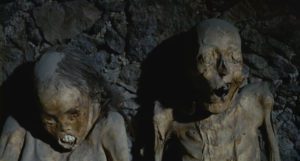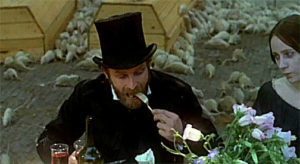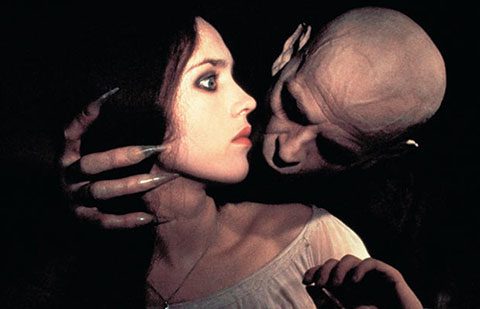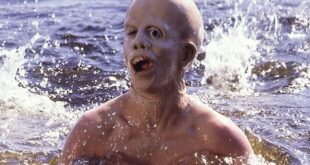Every vampire story is a little bit different. Werner Herzog’s 1979 classic Nosferatu the Vampyre is no exception. For one thing, it doesn’t take place in Transylvania, but in Wismar, Germany, and Herzog’s Dracula (Klaus Kinski) somehow comes across not as mythical but as an inevitable force of nature — like a disease or mighty hurricane. This Dracula is, without a doubt, a tragic, diseased yet imminent figure.
That’s not to say he completely rises above nature and human dealings. Much like the original Dracula, this story starts off in a surprisingly mundane way: Estate gent Jonathan Harker (Bruno Ganz) is assigned to meet this vampire for a lucrative property deal. This makes sense, of course, as the “Count” title in Count Dracula does hint at earthly dealings. That being said, Dracula’s vampirism clearly puts him at odds with leading a normal life, as every moment he appears on screen clearly indicates.
That’s what is tragic about this figure. One gets the sense that, were it not for his affliction, the vampire might actually be a pleasant character, even shy. However, his stereotypical thirst for blood is so great that it makes him an evil, formidable force. At first, Harker is skeptical of what villagers say about Dracula and his castle. However, once he meets the guy, he quickly sees what the villagers were so concerned about. Quite simply, Dracula has a ghastly appearance: Pale skin, sharpened teeth, long fingernails — the whole nine yards. At one point, like in the original Nosferatu, Dracula witnesses Harker cut himself by accident, and is drawn to the blood by his very nature.
If that’s not enough, the vampire gets drawn to something else: Harker’s wife, Lucy (Isabelle Adjani). In fact, her portrait may be the main reason Dracula agrees to purchase the property. This, of course, adds to the tragic nature of the Count’s tale. His repulsive appearance practically assures she could not love him, let alone the fact that she is already married. Thus, a debate is possible: Is he drawn to her because he’s at least partly human or because he’s a vampire cursed to drain all beauty out of the living? This is all part of the atmosphere of doom, which clings to the movie from the freaky opening credit sequence until the end.

Another theme to Nosferatu the Vampyre? The fragile nature of sanity. While Harker is facing the Count, Harker’s boss, Renfield (Roland Topor), is committed to an insane asylum. While the performance doesn’t quite match Tom Waits’ in Bram Stoker’s Dracula, it’s still a memorable, somewhat modern rendition of Renfield. Just as important, it helps feed the general impression that perhaps, madness is an aspect of increasing vampirism.
Oddly enough, I haven’t encountered many views on this topic, though it has obvious merit, given the mental and emotional turmoil so often present in vampire films. While yes, Harker does see the reality of Dracula’s condition, one wonders if it’s partly happening because of the darkness in man (so to speak).
The fear of the villagers, for example, may not simply be due to fear of vampirism, but due to their unwillingness to understand and face the unknown. While vampires may be evil, they seem to represent this idea pretty thoroughly, at least cinematically. It seems Werner Herzog understands this, conveying this impression upon a perceptive audience.
Death Lurks (Or Scurries)!
Another interesting aspect of Dracula is how he must rest in a coffin, thus resembling death even when not afflicted with it. While horror and Goth culture exploit such imagery all the time, Werner does this without really cheapening it — particularly with the twisted, almost otherwordly visages in the opening scene. These images suggest that death is not only inevitable and terrifying, but that it’s creating haunting, morbid art all around us. Herzog’s Dracula, it seems, is merely a logical extension of this reality, as opposed to some trendy pop culture gimmickry.
When Harker attempts to flee Dracula, one gets the impression that it’s futile, and he indeed is injured in his escape. When he is rescued by doctors, they assume he is going insane due to his ranting about black coffins. This, of course, ties in with the insanity of vampirism and how the rational mind can perhaps never reconcile with death itself. After all, death is almost inconceivable intellectually, at least without one becoming morbid in the process. It is almost unseemly to speak cheerfully about it, whatever the context. This is conveyed quite successfully through Herzog’s interpretation.

Indeed, both Herzog and F. W. Murnau tied the Dracula legend together with the plague. However, it took Werner Herzog to truly infest our minds with rats and to skillfully blend the awfulness of disease with macabre humor (a delicate balance, to be sure). We do not just see a ship full of rats, but eventually, there are rats all over the streets bringing death with them.
In the process, Dracula becomes an obvious symbol for plague, injury, insanity and the loss of normalcy. Indeed, when we see people eating dinner on the streets while rats swarm around them, it is apocalyptic imagery at its finest. It’s as if people have forgotten how to live normal lives — a new normal has swallowed sanity.
On that note, Harker returns home, not even recognizing his own wife, Lucy. His mind is clearly a casualty, suggesting that Renfield was merely a preview of what’s to come. The general moral and physical decay is strengthened when Lucy rejects the lovelorn Dracula.
It is an interesting interplay of ideas. Now, obviously, I could write a lot more about this, but you now have a decent idea of how successful this film is at blending realism with surrealism, horror with the mundane. It illustrates how easily terror and death can overcome anyone at any time. So, while Herzog may be a controversial filmmaker, he knew how to do horror right by Nosferatu the Vampyre.
 PopHorror Let's Get Scared
PopHorror Let's Get Scared




